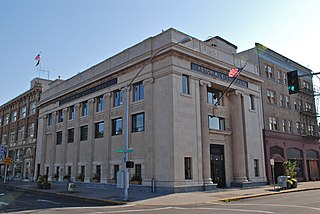
The Columbia River Maritime Museum is a museum of maritime history in the northwest United States, located about ten miles (16 km) southeast of the mouth of the Columbia River in Astoria, Oregon.

The Captain George Conrad Flavel House is a house built in 1901 in Astoria, Oregon. It was listed on the National Register of Historic Places in 1986.

John Virginius Bennes was an American architect who designed numerous buildings throughout the state of Oregon, particularly in Baker City and Portland. In Baker City he did an extensive redesign of the Geiser Grand Hotel, designed several homes, and a now-demolished Elks building. He moved to Portland in 1907 and continued practicing there until 1942.

The United States Post Office in Astoria, Oregon, United States, is a historic building constructed in 1933. It is a two-story building on a raised basement. Its exterior dimensions are 79 by 137 feet. Its 11-bay front facade is divided by flat fluted pilasters with Corinthian capitals supporting a full entablature, with a balustraded parapet above, and a red-tiled hipped roof rising behind that. Its foundations had to be blasted by dynamite.

Emil Schacht was a prominent architect in Portland, Oregon. Schacht's work was prolific from the 1890s until World War I and he produced commercial buildings including factories and warehouses as well as residential projects, hotels and theatres. He is known for his craftsman architecture stlyle homes and was a founding member of the 1902 Portland Association of architects.
Job Ross House at 817 Exchange Street is a historic house in Astoria in the U.S. state of Oregon. The house was built by Job Ross about 1860. The one-and-half story home was also known as Klamath House and is not listed on the National Register of Historic Places. The address of the house was 361 Astor using the street names in force until the late 1890s. Then it became 361 Exchange, until the change in numbering in the 1955, when it assumed its current number. Job Ross lived in the house until his death on April 11, 1895, and his son George W. Ross lived there in 1896.

The Old Astoria City Hall, now known as the Clatsop County Historical Society Heritage Museum, is a historic building located in Astoria, Oregon, United States, that is listed on the National Register of Historic Places. The building served as the city hall of Astoria from 1905 until 1939. It was the first location of the Columbia River Maritime Museum, from 1963 to 1982, and has been the Heritage Museum since 1985.

The Clatsop County Courthouse is a historic courthouse in Astoria, Clatsop County, Oregon, United States.

The Andrew Young House is a historic house in Astoria, Oregon, United States.

The Gustavus Holmes House is a historic residence in Astoria, Oregon, United States.

The Edward Albert Palmer Memorial Chapel and Autry House is a two-part building complex located at Rice University in Houston, Texas. It houses the James L. Autry House, which was built in 1921 by the Episcopal Church as a community center for the university.

Union Fishermen's Cooperative Packing Company Alderbrook Station, on the Columbia River in Astoria, Oregon, was built in 1903. It was listed on the National Register of Historic Places (NRHP) in 1991. The listing included three contributing buildings and another contributing structure on a 4.5-acre (1.8 ha) area.

Astoria City Hall is the current city hall for the town of Astoria, Oregon, United States. Built in 1923 to house a bank, the building became the city hall in 1939, and it has remained Astoria's seat of government for more than 75 years.

The Robert Rensselaer Bartlett House is a historic residence located in Astoria, Oregon, United States.

The John N. Griffin House is a historic residence located in Astoria, Oregon, United States.

The Svenson Blacksmith Shop is a historic commercial building in Astoria, Oregon, United States.

Grace Episcopal Church, also referred to as Grace Episcopal Church and Rectory in the context of historic preservation, is a church, historic church building, and accompanying parsonage, all located in Astoria, Oregon, United States.
Frederick Albert Hale was an American architect who practiced in states including Colorado, Utah, and Wyoming. According to a 1977 NRHP nomination for the Keith-O'Brien Building in Salt Lake City, "Hale worked mostly in the classical styles and seemed equally adept at Beaux-Arts Classicism, Neo-Classical Revival or Georgian Revival." He also employed Shingle and Queen Anne styles for several residential structures. A number of his works are listed on the U.S. National Register of Historic Places.

The Liberty Theater is a historic vaudeville theater and cinema in Astoria, Oregon, United States. The whole commercial building of which the theater is the major occupant is also known as the Astor Building, especially in the context of historic preservation.

The Grants Pass City Hall and Fire Station, at 4th and H Streets in Grants Pass, Oregon, was built in 1912. It was listed on the National Register of Historic Places in 1984.



















